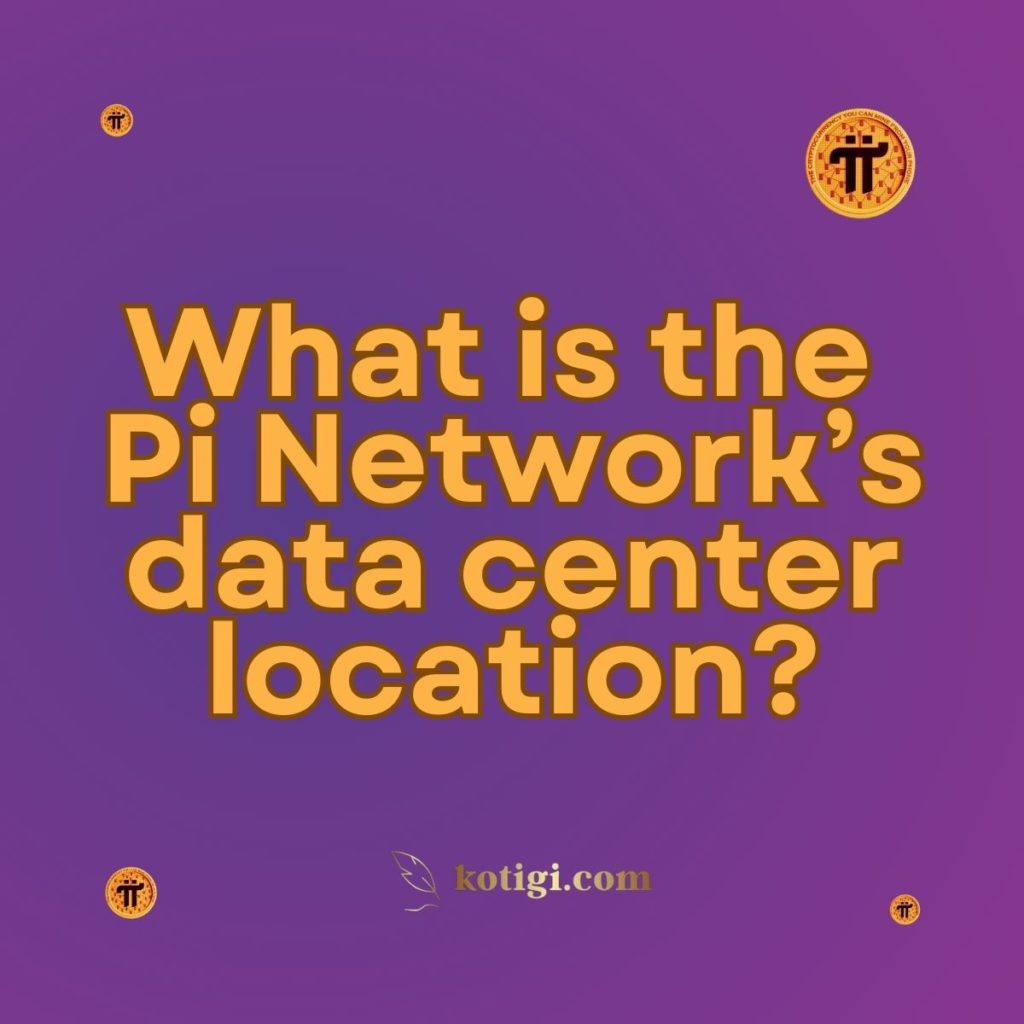
What is the Pi Network’s data center location?
The specific data center locations for Pi Network are not publicly disclosed, but they are likely situated in multiple regions worldwide to ensure optimal performance, security, and redundancy for users.
Introduction
In the digital landscape, the location of data centers plays a critical role in the performance, security, and reliability of online services. For a cryptocurrency platform like Pi Network, which aims to make cryptocurrency accessible to everyone, selecting appropriate data center locations is essential. These locations affect everything from transaction speed to data security.
As cryptocurrency continues to gain traction and more users flock to platforms like Pi Network, understanding the significance of data center locations becomes increasingly important. In this blog post, we will explore Pi Network’s data center locations, discussing their significance, potential advantages, and how they contribute to the platform’s overall functionality.
Importance of Data Center Locations
Impact on Performance
The geographical location of data centers can significantly influence the speed and performance of a network. Proximity to users generally leads to lower latency and faster data access, enhancing the overall user experience. For cryptocurrency networks, where transactions need to be processed quickly and securely, this factor is particularly important.
Latency is the time it takes for data to travel from a user’s device to the data center and back. When data centers are located closer to users, the time taken for transactions is minimized. As a result, users experience faster transaction confirmations and a more seamless experience when using the platform.
In the case of Pi Network, the goal is to create a decentralized cryptocurrency that can be easily accessed and used by anyone, anywhere. By situating data centers in strategic locations around the world, Pi Network can ensure that users from various regions can interact with the platform without experiencing significant delays.
Security Considerations
Data center locations must also take into account regional regulations, political stability, and environmental factors. Secure locations can help safeguard sensitive user data and ensure the integrity of the cryptocurrency network. Given the sensitive nature of financial transactions and personal information shared on cryptocurrency platforms, security is paramount.
A well-chosen data center location should have robust security measures in place to protect against unauthorized access, data breaches, and cyberattacks. Factors such as local regulations regarding data privacy and security can influence the decision-making process when selecting data center locations. By selecting regions with favorable regulations and stable political environments, Pi Network can ensure that user data is managed in compliance with local laws while also safeguarding it from potential threats.
Disaster Recovery
Strategically placed data centers provide redundancy and support disaster recovery plans. In the event of a natural disaster or technical failure, having multiple locations can mitigate risks and ensure continuous service availability. For any cryptocurrency platform, maintaining uptime and availability is crucial for user trust and satisfaction.
Having a diverse geographic distribution of data centers enables Pi Network to implement effective disaster recovery protocols. In case one data center becomes inaccessible due to unforeseen circumstances, traffic can be redirected to other operational data centers, thus ensuring that users can still access their wallets and complete transactions without disruption.
Pi Network’s Data Center Locations
While specific details about the exact locations of Pi Network’s data centers may not be publicly disclosed, it is likely that they are distributed across various regions to enhance performance, security, and reliability.
Diverse Geographic Distribution
Pi Network is expected to employ a diverse geographic distribution of its data centers. This strategy allows for better service delivery to a global user base, ensuring that users from different regions can access the platform with minimal delays.
Having data centers in multiple regions can significantly enhance the overall performance of the Pi Network. For instance, if a user in Asia is trying to access the platform, having a data center located nearby would reduce latency and improve response times. This consideration is particularly important for a platform that is intended for widespread adoption, as it caters to users from diverse geographic locations.
Compliance with Local Regulations
Choosing data center locations that comply with local regulations is crucial for the legal operation of any cryptocurrency platform. Pi Network likely considers legal frameworks related to data protection, financial regulations, and cryptocurrency use in various jurisdictions.
For example, certain regions have stricter data protection laws that may dictate how user data is stored, processed, and shared. By selecting data center locations that align with these regulations, Pi Network can ensure compliance while also building trust with its users. This proactive approach to compliance helps mitigate legal risks and enhances the platform’s reputation.
Infrastructure Quality
The quality of infrastructure in the selected locations can also impact performance. Pi Network’s data centers are likely to be located in areas with reliable power supply, advanced networking capabilities, and technological resources to support high-performance computing.
Robust infrastructure is essential for ensuring that data centers can handle high volumes of transactions and user interactions. This includes considerations such as redundancy in power supply, advanced cooling systems, and high-speed internet connectivity. By situating data centers in regions with strong infrastructure, Pi Network can enhance its ability to process transactions quickly and efficiently.
Advantages of Strategic Data Center Locations
Selecting the right data center locations offers several advantages that can positively impact Pi Network’s operations.
Enhanced User Experience
Strategically located data centers can significantly enhance user experience by providing faster access to services. Reduced latency improves transaction speeds and overall interaction with the platform, leading to higher user satisfaction.
Users are more likely to remain engaged with the platform when they experience minimal delays during transactions or when accessing information. A seamless user experience is crucial for Pi Network’s success as it seeks to attract and retain a large user base.
Improved Reliability
A geographically diverse data center setup can improve overall system reliability. If one location experiences an outage, others can continue to provide service, ensuring that users can always access the platform. This redundancy is vital for building user trust and confidence in the platform.
Reliability in cryptocurrency networks is essential, especially given the financial implications of transactions. Users expect their transactions to be processed accurately and promptly. A reliable infrastructure, supported by multiple data center locations, can significantly contribute to meeting these expectations.
Scalability Opportunities
Having multiple data center locations provides Pi Network with the ability to scale its operations effectively. As the user base grows, the platform can distribute resources efficiently to handle increased traffic and demand.
Scalability is particularly important in the cryptocurrency space, where user adoption can vary widely. By being able to scale operations based on demand, Pi Network can ensure that it can accommodate spikes in activity, such as during market surges or major announcements.
Better Security
By selecting secure locations, Pi Network can protect user data and transactions more effectively. Advanced security measures implemented in these data centers help mitigate risks associated with data breaches and cyber-attacks.
Security is a top priority for cryptocurrency platforms, given the value of the assets being transacted. By choosing data centers in regions with robust security protocols and infrastructure, Pi Network can enhance the overall safety of user transactions and data.
Data Center Technologies and Practices
Modern Infrastructure Technologies
To ensure the efficient operation of its data centers, Pi Network is likely to utilize modern infrastructure technologies. This includes virtualization, containerization, and high-performance computing systems.
Virtualization: Virtualization allows for the efficient use of server resources by creating virtual instances that can run multiple applications simultaneously. This technology can enhance resource allocation and improve overall performance.
Containerization: Containerization, similar to virtualization but more lightweight, allows applications to run in isolated environments. This can lead to improved scalability and faster deployment of new services on the platform.
High-Performance Computing: The use of high-performance computing (HPC) systems ensures that Pi Network can handle complex computations required for processing transactions quickly and efficiently. This technology is vital for maintaining responsiveness and reliability, especially during peak usage.
Green Data Centers
Sustainability is becoming increasingly important in the technology sector, and cryptocurrency platforms are no exception. Pi Network may also consider green data centers that utilize energy-efficient technologies and renewable energy sources.
Energy Efficiency: Implementing energy-efficient practices in data centers can significantly reduce operational costs and environmental impact. This includes optimizing cooling systems, using energy-efficient hardware, and employing smart power management.
Renewable Energy Sources: Utilizing renewable energy sources, such as solar or wind power, can further enhance the sustainability of Pi Network’s data centers. This commitment to green practices not only benefits the environment but also aligns with the growing consumer demand for sustainable practices.
Advanced Security Measures
In addition to physical security, Pi Network’s data centers are likely to implement advanced cybersecurity measures to protect user data and transactions.
Firewalls and Intrusion Detection Systems: These technologies help protect data centers from unauthorized access and potential cyber threats. Regular updates and monitoring can identify and neutralize threats before they compromise the network.
Data Encryption: Encrypting user data during transmission and storage ensures that sensitive information remains secure. This practice is essential for maintaining user trust and compliance with data protection regulations.
The Future of Pi Network’s Data Centers
As Pi Network continues to grow and evolve, its data center strategy will likely adapt to meet the changing needs of its user base.
Expansion Plans
With increasing user adoption, Pi Network may consider expanding its data center footprint to further enhance performance and reliability. New data centers could be established in regions with emerging markets or high user demand, ensuring that the platform remains accessible to all users.
Technological Innovations
The future may also bring technological innovations that could reshape the way Pi Network operates its data centers. Emerging technologies such as edge computing, which brings computation closer to users, could further reduce latency and improve performance.
By leveraging advancements in technology, Pi Network can stay ahead of the curve and continue to provide a seamless user experience. As the cryptocurrency landscape evolves, so too must the infrastructure that supports it.
Focus on User Experience
Ultimately, the focus on user experience will remain central to Pi Network’s strategy. By continuously evaluating and optimizing data center locations, technologies, and practices, Pi Network can ensure that it meets the needs of its users effectively.
Conclusion
The data center locations of Pi Network are crucial to its success as a cryptocurrency platform. By strategically placing data centers around the globe, Pi Network can enhance performance, security, and reliability, ensuring that users have a seamless experience. As the platform continues to grow and evolve, the importance of well-chosen data center locations will remain a fundamental aspect of its operational strategy.
By understanding the significance of data center locations and how they contribute to the overall functionality of the Pi Network, users can appreciate the efforts made to create a reliable and efficient cryptocurrency platform. With ongoing developments in technology and a focus on user experience, Pi Network is well-positioned to continue its growth and impact in the cryptocurrency space.
Key Takeaways:
- The specific data center locations for Pi Network are not publicly disclosed.
- Data centers are likely situated in multiple regions worldwide to ensure optimal performance and redundancy.
- Proximity to users impacts latency and speeds, enhancing the overall user experience.
- Strategic data center locations improve reliability, scalability, and security for the platform.
- Compliance with local regulations is essential for the legal operation of Pi Network’s services.
- Modern infrastructure technologies and practices are likely employed in Pi Network’s data centers to optimize performance and security.
- Sustainability and energy efficiency are becoming important considerations in data center operations.





